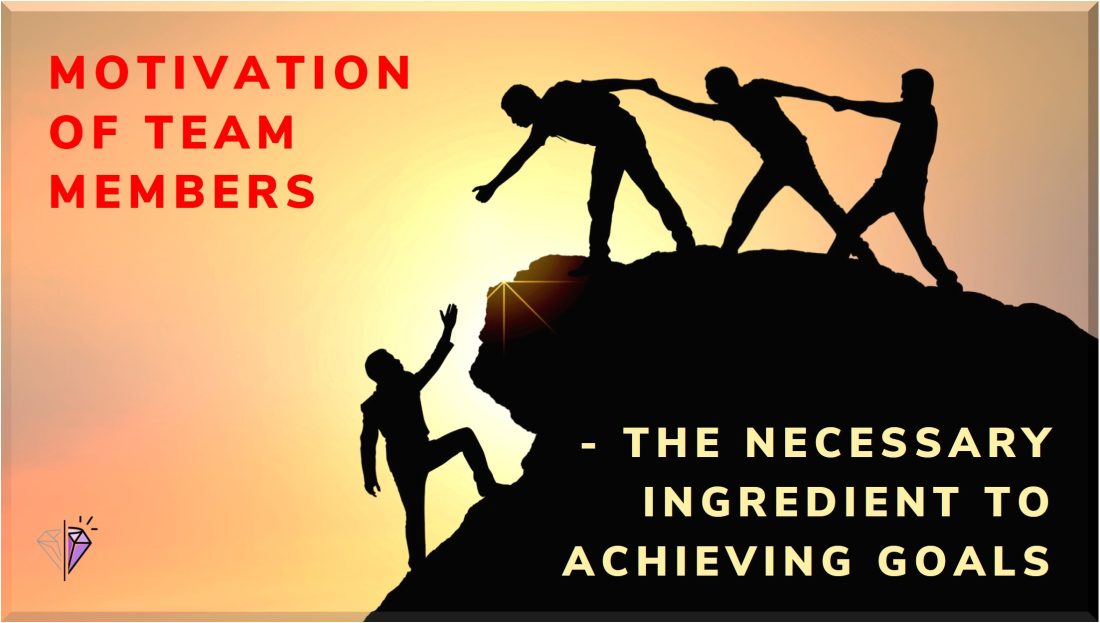
Motivation of team members – the necessary ingredient to achieving goals
Business Coaching
Achieving business goals is anything but easy. It takes a lot of skills, strategies, and psychology to stay consistent and develop a system that really gets results. This text won’t deal with all of them. But it will help you learn how one of the most important psychological components can help you achieve your goals – motivation.
This is important because leaders who understand individual team members’ motivations unlock a powerful tool for driving engagement, productivity, and overall team success, as Forbes’ article clearly explains.
As a leader, you should know how to not only develop motivation but also maintain it as much as possible, because it comes and goes in waves. A tough nut to crack, we know. To start with, here are a few golden guidelines on how to motivate your team to achieve your goals:
♦ Make sure your goals align with their individual and collective goals. People are more motivated to achieve goals that they feel are important and meaningful. And when their personal goals are considered as well. It means that achieving your business goal will help them also achieve their personal goals.
♦ Make them feel accountable for the goals. Involve them in the goal-setting process and allow them to develop their own plans for achieving the business goals. Sharing responsibility and giving the opportunity to co-create their own workplace is key to taking accountability. Accountability means accepting your share of responsibility for the good, bad, and ugly results.
♦ Give them regular feedback and celebrate success. Let your team members know how they’re doing respectfully and factually. But also let them know what they might do in a better way. You know, feedback is the breakfast of champions. And as neuroscientists claim, celebration sends positive signals to the brain to release the oxytocin, dopamine, and endorphins which boost motivation, among others.
♦ Create a culture of collaboration and support. Foster an environment where team members feel comfortable sharing ideas, asking for help, and giving each other feedback through:
1) Brainstorming sessions: Use structured techniques like brainwriting or round robin to facilitate anonymous or individual idea generation before group discussion.
2) Idea suggestion mechanisms: Create anonymous suggestion boxes, online forums, or internal surveys for feedback and ideas.
3) One-on-one meetings: Schedule regular check-ins with team members to discuss their ideas and concerns freely.
4) Rotating leadership roles: Empower team members to lead discussions and brainstorming sessions.
It’s also important to be realistic when setting goals. If your goals are too ambitious or unrealistic, there is a risk that your team members will become discouraged and give up.
Don’t be afraid to ask for help from bystanders. A fresh perspective can help you identify potential biases or blind spots and ensure that your goals are achievable.
How to overcome resistance to change
Resistance to change is a natural human reaction, especially in business settings. Normally people tend to play it safe and stick to what they know because it satisfies the first human need for security and comfort.
But if you want to achieve your goals, you must be willing to embrace change. To overcome resistance, you need to deeply understand the people you’re working with and relate to each team member individually.
What do they need and want in their life now? What are their core values? What motivates them right now to work with you? When you understand their needs, you can tailor your communication and approach accordingly.
Here are a few ideas that might help you with the resistance:
♦ Identify each team member’s core values in the company context. What do they believe is important to the success of the company? How do they want to contribute to the company’s goals?
♦ Understand their motivational direction. Are they motivated by the challenge? Carrots or sticks? The opportunity to learn and grow? The opportunity to make a difference?
♦ Find out their source of motivation. Is their motivation intrinsic (coming from within) or extrinsic (coming from outside)? It’s like fueling a fire: intrinsic motivation is the internal spark, while extrinsic motivation is the added logs.
Once you know your team members well, you can develop a customized approach to communicating with them about change.
Values as the most valuable starting point
Your team’s values are the foundation of your success. Imagine a company as a ship sailing the vast ocean of business. This ship needs more than just a destination and a map to navigate successfully. It needs a strong rudder, powered by a set of guiding values.
When everyone agrees on what’s enormously important, you can make decisions faster, build trust easier, and achieve your goals more efficiently.
To identify your team members’ individual core values, simply ask them what matters most to them about their role and their career in general. What do they actually want to achieve?
Here are some examples of core values:
Once you know the core values of all employees, you can make decisions based on what is important to your team as a whole. This will also help you build a cohesive and productive team that is like a symphony orchestra. Each member, like an instrument, has their unique strengths, preferences, and even a preferred playing style.
Benefit vs. prevention as strong motivators
Motivational direction refers to what drives a person to act. In this context, people can be either benefit-oriented or prevention-oriented.
Benefit-oriented people are energized by goals and rewards. They are motivated to achieve their goals even if they have to take risks to do so.
Prevention-oriented people are motivated to avoid pain and prevent mishaps. They are not so crazy about goals, but they are willing to work hard to predict all negative scenarios and avoid negative consequences.
To find out a person’s motivational direction, you can ask them why it’s important to have the value or criteria they mention. For example, if someone says that it is important to be successful, you can ask them what success means to them and why it is important to them. In this way, you will gain a much deeper understanding.
Here are some examples of how to motivate benefit-oriented and prevention-oriented people:
Benefit-oriented people:
● Set clear and rather challenging goals.
● Offer them rewards and incentives.
● Emphasize the potential benefits of achieving goals.
● Help them develop a plan to achieve their goals.
● Offer support and encouragement along the way.
Prevention-oriented people:
● Emphasize the negative consequences of not achieving their goals.
● Help them develop a plan to avoid negative consequences.
● Support and encourage them to stay on track.
● Celebrate their successes along the way.
It’s important to acknowledge that everyone is different and, in some contexts, the same person can be motivated by benefits whereas in others by prevention. And some people are motivated by an equal combination of benefits and prevention. It’s critical that you understand what motivates each individual in a given context and tailor your approach accordingly.
To praise or not to praise
The secret to effective praise is to understand the motivational source of the person you’re praising. In other words: What motivates them to do their best work from the outside?
Internal people are motivated by their own inner voice and reasoning. They know when they’ve done a good job because they feel good about it. They don’t need much feedback or praise from outside.
External people, on the other hand, are motivated by outside influences and opinions. They need praise, recognition, and guidance to feel good about their work.
The magic question that can help you determine a person’s source of motivation is: How can you tell you’ve done a good job?
If the person answers, “I feel good about it,” “I’m proud of myself,” or “I know I did my best,” then they’re probably an internal person.
If the person answers, “When I get positive feedback from my boss or colleagues,” “When I get promoted or get a raise,” or “When I win an award,” then they’re probably an external person.
Once you know the person’s source of motivation, you can tailor your praise accordingly.
For example, when praising an internal person, focus on their accomplishments and the impact of their work. Say things like, “I’m impressed with how you handled that difficult customer,” or “Your work on that project was top-notch.”
When praising an external person, focus on their effort and commitment. Say things like, “I really appreciate your hard work on this project” or “I’m proud of how you’ve progressed in this role.”
Praise is a powerful tool, but it’s important to use it wisely as it doesn’t work always. If you know the different sources of motivation, you can tailor your praise to make your employees feel good about their work and motivated to keep going.
No friction in a well-oiled machine
Profiling team members is an important step in setting goals and achieving success. Knowing the strengths, weaknesses, and motivations of your team members will help you build a more effective and cohesive team.
Imagine a team that works like a well-oiled machine. In which everyone knows their role and fills it to the best of their ability. In which friction or conflict is rare but constructive, and everyone works towards a common goal.
That’s what team member profiling can do for you. It’s the key to building a high-performing team that can achieve anything.
So don’t wait any longer. Start profiling your team members today and see how it can transform your business.
We can also help you with the profiling so that you increase the chances of your success. Book your free first appointment.











